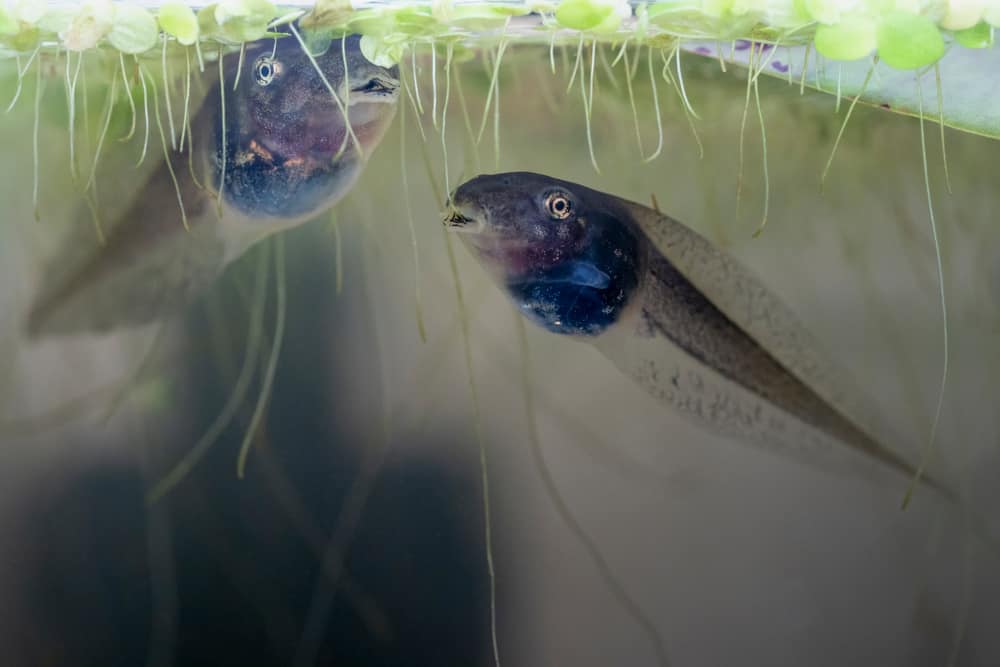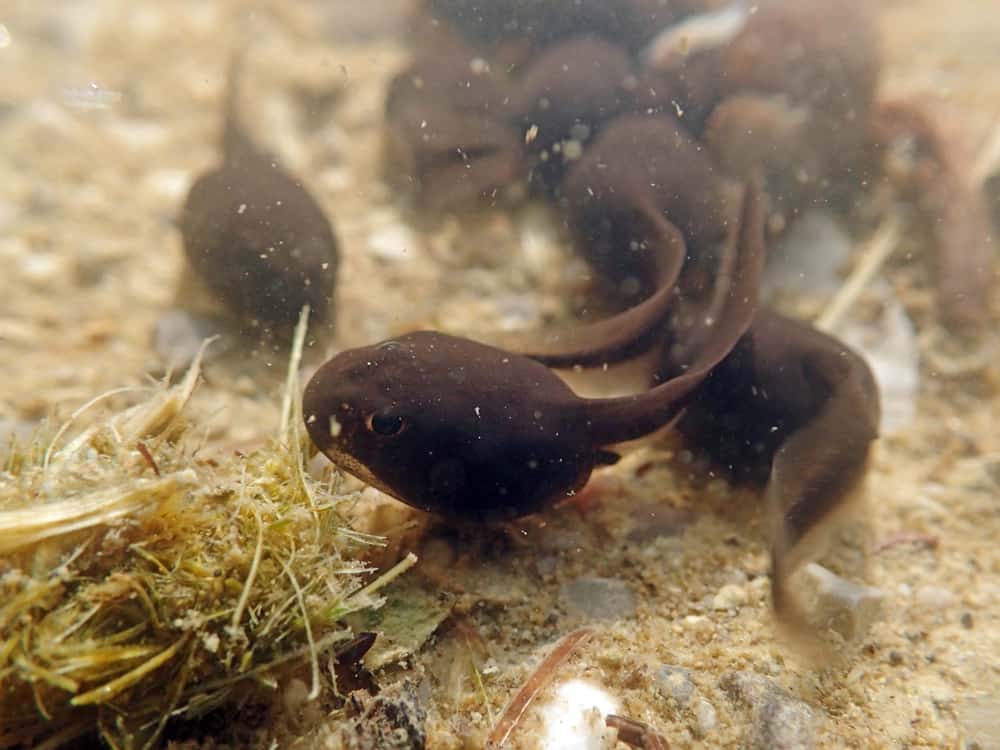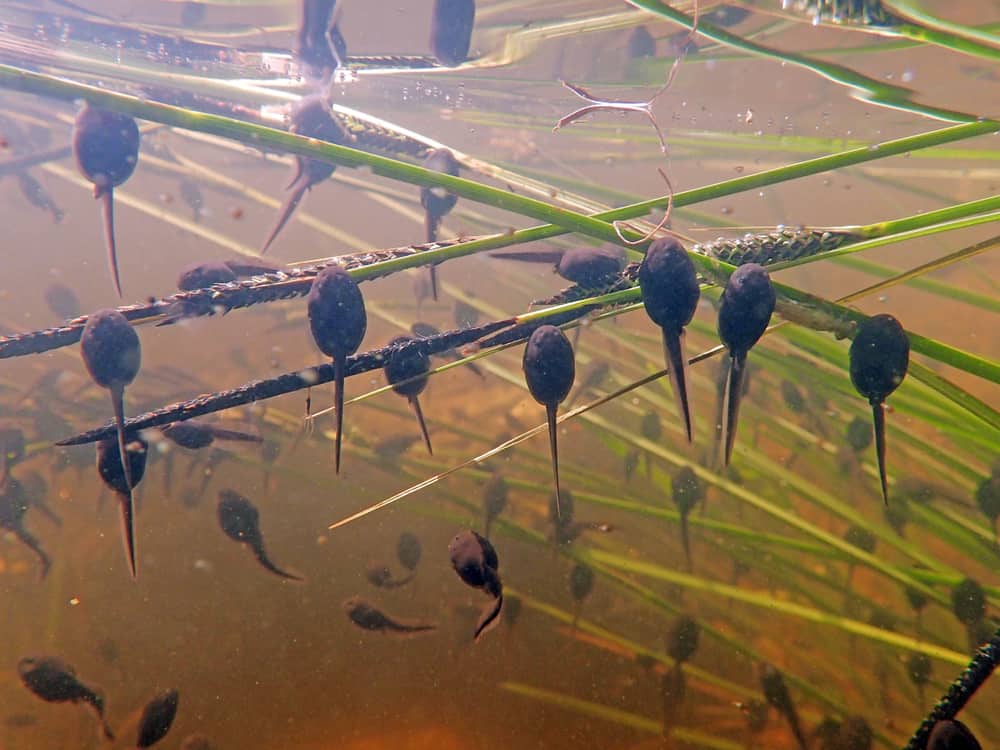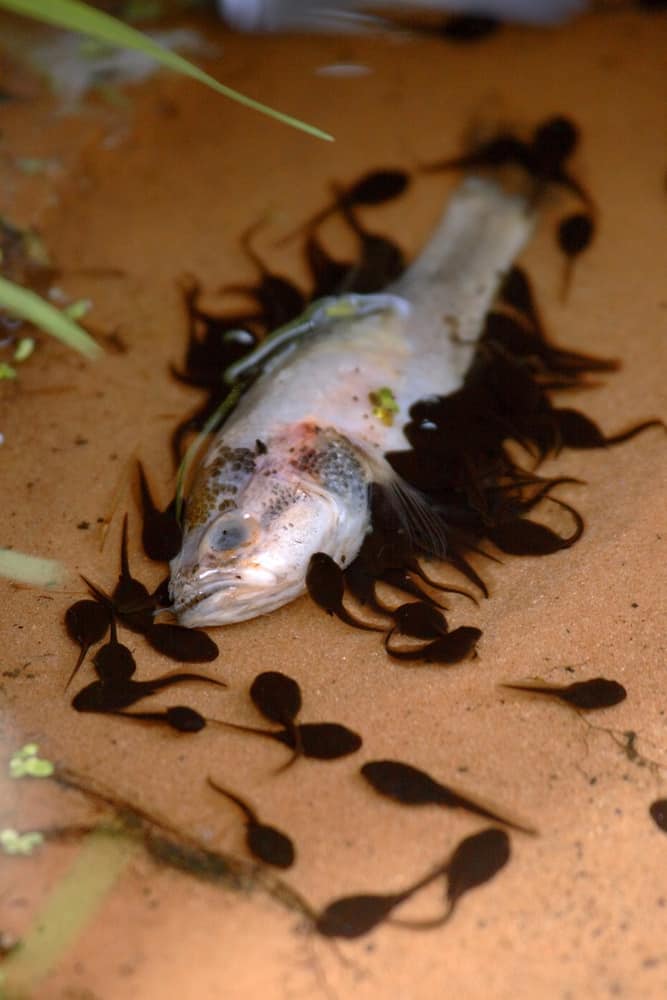You may confuse them for fish upon first sight, but if you take a closer look, you’ll be shocked to realize they are amphibians.
Tadpoles are basically baby frogs or toads. Just like teenagers, as they grow, they feed voraciously on whatever they can fit in their mouths.
So, what do tadpoles like to eat most? Let’s see what’s on the menu.
Tadpoles Habits And Biology
Tadpoles, also known as polliwog, are the larval stage of amphibians. Whereas the majority of the tadpole species are fully aquatic, some species are terrestrial.
Terrestrial tadpoles such as the Ranixalidae inhabit wet crevices (cracka in walls) near ponds or streams from which they get their food.
Like fish, tadpoles swim together in schools. They actively seek food but downplay their activity when they encounter predators. They feed numerous times a day to get sufficient nutrients required to grow at a rapid rate.
Tadpoles of frogs are primarily herbivores who feed on soft decaying plant matter. On the other hand, salamanders and caecilians are carnivores.
Over time, tadpoles of the New Mexico Spadefoot toad (Spea multiplicata) develop a carnivorous diet along with a broader head, more prominent jaw, and shorter gut to adapt to food scarcity.
Other tadpoles are prone to cannibalistic tendencies during the scarcity of food. Its survival of the fittest as they turn on their pond mates.
Some genera of the tadpole species, such as the Pipidae and Microhylidae, are plankton feeders. They spend time swimming through the water column feeding on plankton. Tadpoles feed on planktons through filtration of water.
Planktons are microscopic organisms that drift in the sea or freshwater bodies. They consist predominantly of diatoms (algae), protozoans (single-celled microscopic organisms such as amoeba), crustaceans, and larger animals’ eggs and larval stages.
Tadpoles also have long spiral-shaped guts, which enable them to digest organic matter efficiently.
With the above adaptations, these tiny amphibians are sure to make it through to adulthood, provided that luck is also by their side.
It takes about six weeks for some species of amphibians to reach maturity. Whereas, in other species, it may take up to three years for tadpoles to complete development.
Do Tadpoles Eat Dirt?
Yes. Tadpoles do eat dirt. The Kallars dancing frog (of species Micriscilus herrei) have bodies that help them burrow into the sand and gravel.
Amphibian biologist Sathyabhama Das Biju discovered The Kallar dancing frogs in the Western Ghats of Southern India.
The tadpoles spend their time below ground eating sand and bits of organic matter. The Kallars’ frogs’ tadpoles have eyes covered with skin and eel-like tails for mobility.
The creatures possess saw-edged jaw sheaths that act as filters to prevent large sand particles from entering their mouths; thus, preventing large soil particles from interfering with digestion.
Other species of tadpoles feed on detritus which is either dirt produced from soil erosion or organic matter produced by decomposing organisms.
What Do Tadpoles Eat Most?
Contrary to popular belief, tadpoles don’t have identical diets as their adult counterparts. Most tadpoles are herbivorous in their early stages. They primarily feed on soft plant matter such as algae.
Their diets vary from species to species. Tadpoles, on hatching, feed on the yolk from their eggs as it is rich in nutrients.
- Later they find shelter under aquatic plants such as lily pads which also act as their food source.
- Later as they grow, they adapt to an omnivorous diet. Tadpoles will hunt for small prey like mosquito larvae or small redworms.
- They only resort to eating meat when aquatic vegetation is scarce.
Tadpoles in the wild tend to eat whatever is readily available to them. Like all other polliwogs, they begin with their egg yolks and then feed on tender plant matter.
As they continue to grow, tadpoles will also eat:
- Mosquito larvae –are young ones of mosquitoes that are hatched in water and provide a staple diet for tadpoles.
- Duckweed –are flowering aquatic plants that grow on water surfaces.
- Mosses –are flowerless green plants that grow in damp areas.
- Detritus –is waste or debris produced by erosion or organic matter produced through the decomposition of organisms.
- Bacteria –are large groups of unicellular microorganisms.
- Protozoa –are examples of planktons.
- Water striders –are bugs that move swiftly across the surface film of water using their legs for mobility.
- The remains of dead animals in the waters they inhabit are rich in nutrients.
- When food is scarce, they will go as far as eating each other.
- Frog eggs –are rich in proteins that mainly make up the tadpoles diet.
Tadpole species that dwell in ponds have much more limited diets. Their daily bread essentially includes mosquito larvae and algae.
- Like their counterparts dwelling in the wild, they eat what is available. Therefore, when the pond is full of fish, they eat fish eggs and dead fish.
- Omnivorous tadpoles will also feed on frog eggs and each other when the going gets tough.
Foods to feed your pet tadpoles:
- Broccoli –should be well boiled for no less than five minutes and chopped into tiny pieces before feeding tadpoles.
- Spinach –should also be boiled in the same way as other veggies and chopped into small pieces before being offered to the tadpoles.
- Fish food –should only be used when no other source is available to feed the tadpoles.
- Algae wafers –are made by compressing different types of vegetable matter and various types of algae.
- Egg yolks
- Green peas
- Zucchini
- Insects like aphids.
All the foods named above are sources crucial for developing tadpoles and aid in their transition from hatchling to frogs. They are rich in nutrients like proteins, vitamins, and other minerals to sustain their survival.
Foods To Avoid Feeding Tadpoles
On the broad menu of a tadpoles diet, certain foods could prove harmful if ingested. A number of these items include:
- Chlorinated water –can prove to be hazardous to these amphibian babies. Water intake in tadpoles occurs through the skin. Chlorinated water contains chemicals that may harm the animal.
- Algal bloom (algae growth on or near water surface) is the most common cause of tadpoles’ sudden death. Warm weather and green coloration of water indicate the high growth rate of algae in the water.
- Unfamiliar foods – may be challenging for the tadpole to digest as their digestive tracts will find it difficult to absorb nutrients from the foods.
Other foods that should not be taken by tadpoles or given to them include:
- Dog food –contains grains that tadpoles cannot digest.
- Cat food – also has grains that tadpoles cannot digest.
- Fish food –should only be used as a last resort if no other food is available.
- Bugs or larvae caught in the wild –carry diseases or parasites harmful to the tadpoles.
- Processed foods –contain a lot of preservatives and chemicals that will ultimately kill the tadpoles.
- Bread –has no nutritional value.
- Fruit –is rich in sugars which wouldn’t be advisable as a prominent part of a tadpole’s diet.
- Meat –such as beef shouldn’t be a prominent part of their diet. Tadpoles have digestive tracts meant for plant matter and not meat.
Take note of these harmful food substances when feeding tadpoles, especially if you consider keeping them for pets.
Tips To Feeding Tadpoles.
Keeping frogs as pets compared to tadpoles are very different things. Tadpoles require just as much effort to care for as frogs do. They are tiny creatures; hence, one has to be careful in handling and looking after the tadpoles.
To maintain a good life and contribute to the pets’ longer lifespan, here are some steps you can follow when feeding your tadpole:
- Ensure to pick a suitable container to keep your tadpoles. If possible, store your tadpole in an aquarium or a container that resembles the same.
- The container should preferably be glass or plastic for easy monitoring of the creatures.
- Establish a suitable habitat for the tadpoles. Ensure to keep the container in which your tadpoles will live is in a well-shaded area.
- When the water in the container gets dirty, use a net or jar to transfer the tadpole into a different container –preferably smaller.
- Thoroughly clean the tank before returning the tadpoles to their original container.
- Ensure your water is safe for tadpoles. Tadpoles need clean water to flourish. Preferably use fresh tap water for your tank or aquarium.
- When cleaning your pets’ tank, avoid using chemical cleaners as they could harm your tadpole.
- Ensure to feed your tadpoles a healthy diet consisting of veggies such as lettuce or spinach, and make sure they are well boiled.
- Once the veggies boil, drain and chop them into small pieces and feed them to your tadpoles.
Following these simple steps will ensure your pet tadpoles make it safely to their next phase of maturity as frogs.
Summary
Now that you know what tadpoles like to eat most, you can consider yourself an expert in tadpole husbandry. How does it feel?
It’s a fulfilling experience to watch these magnificent creatures undergo this miraculous process that is metamorphosis. That’s what you call frogress (progress)!



